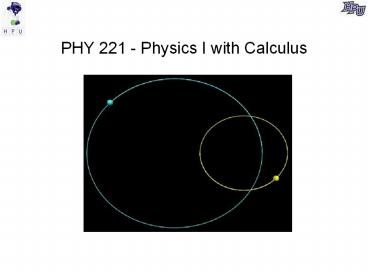PHY 221 - Physics I with Calculus - PowerPoint PPT Presentation
1 / 13
Title:
PHY 221 - Physics I with Calculus
Description:
Each day will consist of lecture and/or lab, which includes experiments and ... Textbook: Matter & Interactions, Vol. I, 2nd edition, by Chabay and Sherwood. ... – PowerPoint PPT presentation
Number of Views:22
Avg rating:3.0/5.0
Title: PHY 221 - Physics I with Calculus
1
PHY 221 - Physics I with Calculus
2
Syllabus
Course web site http//linus.highpoint.edu/ati
tus/courses/phy221/ Email hpuphysics_at_gmail.com T
witter _at_appleandplanet Lecture and Lab are
integrated. Each day will consist of lecture
and/or lab, which includes experiments and
computer programming/modeling. Textbook Matter
Interactions, Vol. I, 2nd edition, by Chabay
and Sherwood. Homework WebAssign log in
through Bb collaboration is encouraged. Help
Solutions to practice problems are posted at
http//linus.highpoint.edu/atitus/mandi/ Class
Participation Clicker is required.
3
Syllabus
Grading Scale A (96), A (92), A - (88), B
(84), B (80), B- (76), C (72), C (68), C- (64),
D (60), D (56), D - (52), F (lt52). Grade
Calculation lab (15), homework (10), class
participation (5), quizzes (50 5 quizzes, 10
each), final exam (20). Lab includes lab reports
and a project. Quizzes 6 quizzes lowest is
dropped. Any missed quiz is a zero. If two
quizzes are missed with excused absences, the
final exam will count for the quiz grade. Final
Exam Dec. 12, 130 PM -- 430 PM
4
Syllabus
Use of Technology During lectures and lab, use
of cell phones and computers for social purposes
is strictly forbidden. You may use phones and
computers for learning physics and communicating
physics in class. You must be engaged with the
material being presented in class and lab. We
have no spare time, so stay on task.
5
Syllabus
- Learning Objectives
- apply a small set of fundamental physical
principles to a wide variety of physical
situations. - The Momentum Principle (Newtons second law, or
Conservation of Momentum) relates forces and
motion. - The Energy Principle (Conservation of Energy)
accounts for energy exchanged between a system
and its surroundings and energy transformed
within a system. - The Angular Momentum Principle (Newtons second
law for rotation, or Conservation of Angular
Momentum) governs torques and rotational motion. - Physics is fundamentally simple.
6
Syllabus
- model complicated physical systems by making
approximations and idealizations in order to
apply fundamental principles.
A solid can be modeled as balls connected by
springs.
7
Syllabus
- 3. use these fundamental principles to explain a
wide variety of macroscopic and microscopic
physical phenomena. - such as orbits, oscillations, projectile motion,
projectile motion with air resistance, transverse
waves on a string, longitudinal waves in a gas,
buoyancy, bond stiffness, diatomic molecules,
quantized energy and angular momentum of a
hydrogen atom, and many more
8
Syllabus
- use these fundamental principles to predict the
behavior of a variety of physical systems. - What initial velocity is required to make a
free throw in basketball? - 5. learn experimental skills such as video
analysis, uncertainty (i.e. experimental error),
analysis of graphs, curve fitting, computer data
acquisition.
9
Syllabus
6. develop computational models.
- A computational model includes
- Assumptions
- Physical laws
- Numerical methods
http//myfoxmedia.com/wordpress/wp-content/uploads
/2009/08/models_storm3.jpg
10
Syllabus
Goals Have Fun! Work your butt off (so that
you walk funny at the end of the semester) Work
together(this is a collaboration between you,
me, and your classmates) Be a scientist(you are
discovering the rules of the game)
11
Richard Feynman
http//www.youtube.com/watch?vo1dgrvlWML4
12
Checkerboard Universe
Select one person in your lab group to be
God. The others will be the scientists. Afte
r each Universe is discovered, change roles and
have another person be God.
13
(No Transcript)































